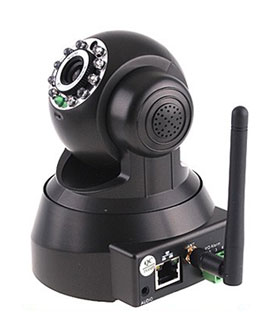While much attention in the media has rightly focused on the theft of credit card information at large retail operations such as Target and Micheals, other security breaches have been underreported. One particular and unexpected example is the hacking of home devices other than laptops, desktops, and tablets.
Hijacking Home Appliances

The Chinese company Foscam, a manufacturer of web-based IP surveillance cameras, first came into the news last August when a couple in Texas discovered the baby monitoring camera they were using had been hacked.
They discovered this when, on entering the child’s room, they heard a male voice speaking through the device to the child. Recently, another security expert has identified a further system wide flaw in Foscam cameras which allows for a digital bandit to view live and recorded footage.
As more and more devices come online, creating the long anticipated Internet of Things, new possibilities arise for those with malicious intent. End users who install these devices in their offices, vehicles, and homes need to be aware of the necessity of securing each device and connection, and of keeping security up to date. Given the stories of celebrity phones which have been hacked, it may seem obvious that a camera would be a likely potential target of criminals seeking salacious content. However, any appliance which has an internet connection has the potential to be attacked and misused.
It seems counterintuitive to assume that a refrigerator could be used for harming anything other than one’s waistline. When given an IP address and a wireless connection, along with some form of operating system, this everyday necessity is no longer just a refrigerator, but a viable mechanism for hackers to subjugate to their cause. Such was the case in December of 2013, as hackers cracked into over 100,000 separate devices across the country.
The variety of items exploited ranged from SmartTVs and multi-media centers connected to the internet to unsecured routers and at least one refrigerator. The hackers used the devices to send out waves of spam email. The more devices which are compromised, the less likely it is that security personnel will be able to trace the source of the attacks. These wide spread, multi-pronged attacks could use any device which has an IP address and connects to a home or business internet connection.
How to Avoid Getting Hijacked
The question which arises from these examples is what can an individual do to protect the integrity of their home network? Rather than choosing to forego Smart appliances altogether, a few simple steps can aid in making ones home a hard target and far less likely to be exploited.
First, be sure that when a new device is installed, the default password is changed to something unique and personal. While it may be difficult to keep track of the wide variety of passwords necessary for multiple devices, it is potentially more difficult to deal with a security breach.
Second, read and understand all the accompanying instructions with any new appliance. The extra few minutes taken to ensure proper installation and usage will be better spent now rather than after a problem develops.
Third, change passwords often. Create a security maintenance schedule for all your devices during which you change passwords and update any necessary security measures.
Finally, if you have any concerns about your ability to secure your systems, consult a professional.
In a time when groups of criminals can use the internet to access your bank account or other personal information, digital and data security have become as important as physical security. Take the time to be sure your privacy is protected.